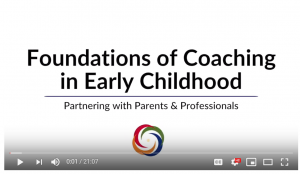Coaching
Connecticut Birth to Three Services & Supports
The Connecticut Birth to Three system promotes the use of the following research supported practices: Natural Learning Environment practices, Coaching as a style of interaction, and Primary Service Provider approach to teaming.
20 minute coaching video describes the practices of coaching as a style of interaction. Reviews the five key characteristics of coaching with video examples on a Birth to Three home visit, in-home childcare, and center based childcare.
Coaching: A Style of Interaction – not a model of service delivery
The coaching style of interaction is based on adult learning principles and is a way to interact with parents, caregivers and other team members to build their confidence and competence in order to enhance child learning and development within the typical activities of the family. It fosters problem solving and planning for actions the parent will take to support their child’s development and learning.(1)
The role of the coach (Early Interventionist) is to “identify the parent’s priorities for their child’s development, determine what they already know and are doing in relation to their child’s development, share new information and ideas, and then work together to support the child’s participation and expression of interest within everyday activity settings to provide opportunities for learning.”(2)
The key elements of the practice dictate that coaching should be:
- consistent with adult learning
- capacity building
- nondirective
- goal oriented
- solution focused
- performance based
- reflective, collaborative
- context driven
- as hand-on as it needs to be (2)
There are numerous studies that support use of coaching as an interaction style with adult-learners and the benefits of using a coaching style for developing competence in the learner. (3) As noted by Rush and Shelden through review of 39 published studies, the key characteristics of coaching that build confidence and competence in parents include:
- Joint Planning : to collaboratively determine the specific activities and strategies the parent will focus on during and between visits, and for parents to determine the specific activity that will be the focus of the next visit
- Observation: of the parent and child by the interventionist during the visit
- Action: taken by the parent with the child during the visit and between visits
- Reflective questions: to determine what the parent already knows and is doing, as well as to foster analysis of information and generation of alternative ideas by the parent
- Feedback: from the interventionist that is affirmative and informative, including sharing research-based knowledge and hands-on modeling followed by practice by the parent (4)
_____________________________________________________________
References
1 Rush D. D., Shelden, M. L. (2011) The Early Childhood Coaching Handbook. Baltimore, MD: Paul H. Brookes Co. (p. 8)
2 Rush D. D., Shelden, M. L. (2011) The Early Childhood Coaching Handbook.Baltimore, MD: Paul H. Brookes Co. (pp 9-12)
3 Bibliography on references related to evidence-based coaching practices
4 Rush D. D., Shelden, M. L. (2011) The Early Childhood Coaching Handbook. Baltimore, MD: Paul H. Brookes Co. (p. 15-23)
_______________________________________________________________
Resources
Fact Sheet: Coaching practices
Common Misperceptions about Coaching in Early Intervention – Rush, Shelden
A Framework for Reflective Questioning When Using a Coaching Interaction Style – Rush, Shelden, Raab
Evidence-Based Definition of Coaching Practices – Rush, Shelden
Example of Coaching and NLE Practices for family with child with autism – Donovan Family Case Study
